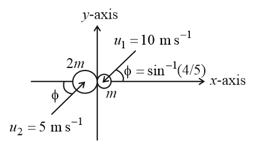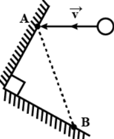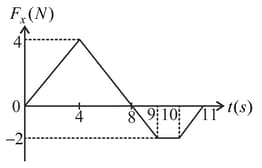A ball of mass , moving with uniform speed, collides elastically with another stationary ball. The incident ball will lose maximum kinetic energy when the mass of the stationary ball is

Important Questions on Centre of Mass, Momentum and Collisions
Two smooth spheres made of identical material have masses and undergoes an oblique impact as shown in the figure. The initial velocities of the masses are also shown. The impact force is along the line joining their centres along the -axis. The coefficient of restitution is . The velocities of the masses after the impact and the approximate percentage loss in kinetic energy.

is an -shaped obstacle fixed on a horizontal smooth table. ball strikes it at gets deflected and restrikes it at . If the velocity vector before collision is and coefficient of restitution of each collision is , then the velocity of ball after its second collision at is

A toy car can move along an axis. Graph shows force , acting on the car which begins at rest at time . The velocity of the car at is

